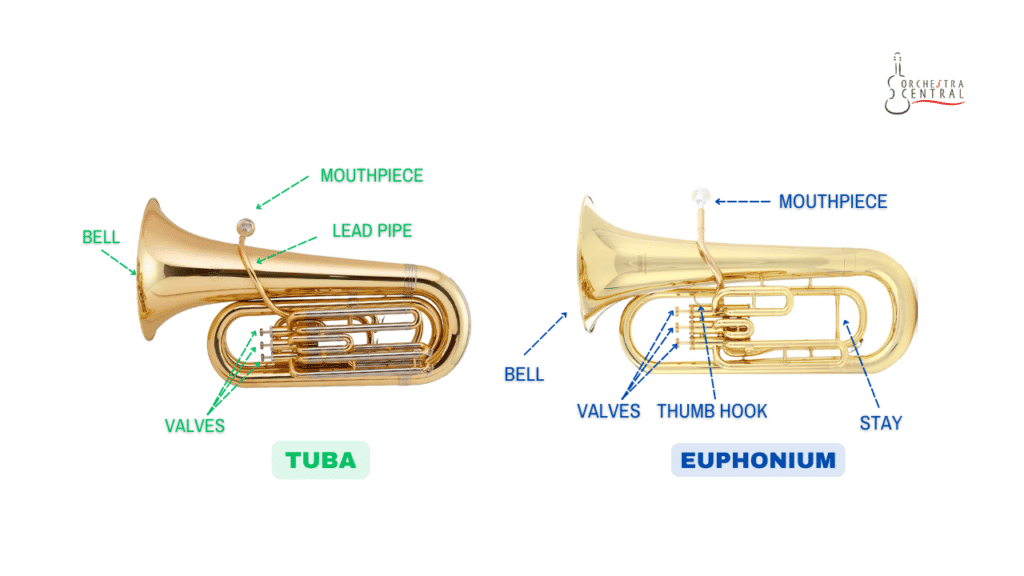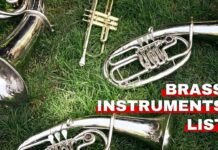A euphonium instrument is crucial in many music genres, including classical, jazz, and brass bands. If you are a beginner or looking forward to learning this instrument, this guide will explain everything you need to know.
What Is a Euphonium?
The euphonium is a brass instrument with a conical bore and a flared bell. It differs from a tuba in its smaller size and narrower bore. It also differs from a baritone horn because of its larger bore size. However, they share the same B♭pitch, which means they work best for music in either bass clef or treble clef.
Many describe the sound of the euphonium as rich, warm, and whole, often likened to a human voice. As a matter of fact, its derived Greek word (euphōnos) translates to “sweet voice.” This is why euphonium’s tone suits slow, lyrical melodies and orchestral and brass band music.

Fun Fact: The Euphonium is a young instrument, first appearing in the mid-19th century after its invention by instrument maker Sommer of Weimar.
Sommer based the instrument on the tenor horn, which had a similar shape and bore. Euphonium fills the gap between the trombone and the tuba in brass or military bands. It also has a valve system that changes the tubing length, altering the notes’ pitch.

Like other brass instruments, the euphonium produces sound by vibrating the lips against a mouthpiece.
This brass instrument is arranged in a compensating system. When you direct airflow into the device, the compensating mechanism will return the pitch to its intended pitch. That will be regardless of the harmonic series. As such, a Yamaha Euphonium becomes a flexible instrument for playing long and intricate melodies with pure tones.
What Are the Different Types of Euphonium
Euphonium has existed since the early 19th century. Initially, musicians used it as a valve-based instrument to bridge the gap between the tenor and baritone horns. Today, the euphonium is available in several variations. Some have three valves, while others have four. There are also differences in the range of notes they can play.
Compensating

If you are a beginner, compensating euphoniums are highly recommended because of their note range, durability, and economical price tag.
The compensating system adds extra tubing to the instrument, resulting in a lower pitch of notes that would otherwise be out of tune. You can use this technique for blending with other brass instruments in ensembles and orchestras.
Additionally, compensating euphoniums have larger bores and conical tubing to produce richer sounds. These features that resemble those of a besson euphonium make them ideal for solo performances. As such, the instruments can hold up against rigorous playing demands while producing clear notes.
Its valve system ensures you can easily produce a range of dynamic expressions.
Non-compensating
Non-compensating euphonium often features four valves with a lowered 2-1/2 step pitch. Professional euphonium musicians often use this type because of its expressiveness and musical agility over extended range or expansive sound projection. Non-compensating euphoniums also allow for more precise phrasing, dynamic control, and tonal modulation.
However, the suitability of any model depends on its specific configuration, acoustic properties, intonation characteristics, and preferences. As such, consider its construction materials, manufacture quality, playability attributes, tuning accuracy, and ergonomics features.
Double-Bell
This complex instrument has two bells of varying sizes, producing distinct sounds that allow you to switch in a performance – use the larger bell for lower-register sounds while the smaller bell for higher-pitched notes. This multifunctional design allows for greater versatility in musical pieces.
While only some professionals use it as their primary instrument, it has had a tiny but dedicated following. If you’re playing louder, the smaller bell might provide a more natural sound. For added flair, you can use the bells for echoes or to simulate a call-and-response with the audience using distinctive tones.
Professional musicians favor the double-bell euphonium for its ability to blend with other brass instruments seamlessly. You will need technical skill and artistic sensitivity to master the double-bell euphonium.
Marching
You can use this tenor tuba or baritone horn in marching bands and drum corps. It resembles a baritone horn but has a wider bore and larger bell. Place your mouth on the cup-shaped mouthpiece and press the valves to change the pitch. The marching euphonium can play from low Bb to high F# and requires strong breath.
Military parades use this instrument to add depth and power to the ensemble’s sound. Its versatility makes it essential to any brass band or wind ensemble. It also resembles the baritone Euphonium, a popular symphonic band and orchestras choice.
Five Valves
This recent invention has an extra valve to increase the tubing length and allow the instrument to play lower notes. Opening and closing these valves will enable you to access new pitches unavailable on a standard four-valve model.
The extra valve on a five-valve euphonium is often called a compensating valve. This valve helps the instrument maintain a consistent tone and intonation. When playing low notes, the tubing of the euphonium can become quite long. That may result in the pitch dropping off and the sound becoming muddy. The compensating valve adjusts the pitch and volume of the note to compensate for these changes in tubing length.
The instrument also has an increased range. You can access lower notes and thus add depth and richness to your playing. However, playing a five-valve euphonium does need some extra skills and practice. The valves are slightly different than on a four-valve model. Thus, it would help if you learned to use them efficiently. The added tubing can also make the instrument more cumbersome for younger players.
How to Play Euphonium Instrument
Playing the euphonium requires skill, patience, and dedication. If you are a beginner, consider the following steps to become a master.
- Get the right equipment. Have a euphonium, a mouthpiece, and a music stand.
- Get into the proper position. Sit on a chair and sit up straight. Make sure that you are knees are at a 90-degree angle. Your feet should touch the ground, and the euphonium should be between your legs. Your left hand should rest on the first valve slide, and your right hand should hold the valves.
- Start practicing breathing exercises by taking deep breaths and exhaling slowly.
- Practice producing sound by playing different notes. Ensure you place your lips on the mouthpiece and blow air through it.
- Learn to read music and understand the different rhythms and melodies.
- Practice playing scales and arpeggios at different tempos to improve finger coordination.
- Master different musical pieces by practicing various styles of music, such as classical, jazz, and pop.
- Practice playing with a group. Join a concert band or orchestra to practice playing with others.
Tip: Taking lessons from a professional euphonium player can help you improve your skills. A teacher can give you personalized feedback and help you overcome any obstacles.
Conclusion
The Euphonium instrument requires dedication and hard work to become a skilled player. Remember to choose the right equipment, practice good breathing and posture, and focus on mastering the fundamentals. You can become the pro player you always wanted to be with persistence and patience.
Table of Contents




